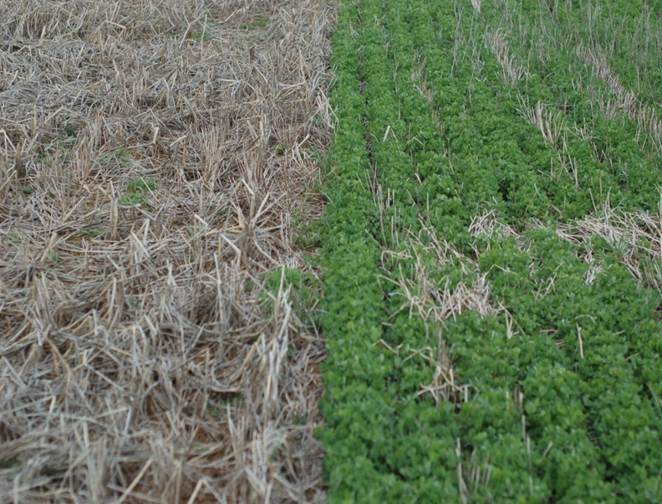
There may be more over-winter cover crop options than you may think. Winter is one of the most flexible seasons for cover crop use; you just have to consider what’s most appropriate: an over-wintering cover crop or a winter-killed mulch, as well as the timing to get it established.
Winter-Killed Mulch
This is the easiest option to work with in a no-till situation. Spring/fall and summer crops cannot tolerate hard frosts; plant them in late summer, and they will mature and winterkill with the onset of winter, providing a thick killed mulch residue that keeps soil covered and protected, and allows you to plant into the residue early in the spring if you desire. The window of time in the spring that is usually left for spring growth of the winter annual cover crop to reach maturity is not necessary, buying a little time and flexibility in the rotation to plant a spring crop.
This approach is popular with produce growers who want a cover crop over winter but want to be able to plant early spring vegetables as soon as the ground can be worked in the spring. It is applicable in many operations and can work well in most regions. It may also be useful in the north where the growing season is short and spring planting considerations, such as wet soils, may not always favor the early timing needed to kill an over-wintering cover crop.
This type of cover crop takes up and retains many nutrients in its tissues, even after it winterkills. Potassium may start to leach, but phosphorus and other nutrients will be mostly retained until the material starts to break down in the spring. Nitrogen is intermediate and may start leaching out as the plant tissue dies and breaks down depending on C:N ratios of the material.
Residue from the killed cover crop provides weed suppression over the winter, which may continue early into the growing season if the spring crop is planted directly into it (this depends on the species and how much biomass it produces before it winterkills). Oats planted late, for example, will kill before they have a chance to grow much biomass, which means less organic matter and weed control.
A crop like Spring Pea-Oat Mix could also be planted in late summer with the intended use as a fall forage. Planted at a slightly higher seeding rate, it can be grazed or cut for forage in late fall, or this same option can be used as a winter-killed cover crop mulch.
King’s AgriSeeds sales reps get many calls about this method of winter-killed cover cropping, and university researchers look at this in the context of nutrient cycling.
Spring and Warm Season Crops to Use for a Winter Killed Mulch
For planting at oats planting date, late summer
- Spring oats
- Pea-oat mix (contains spring peas; everything in mix will winterkill)
For planting mid to late summer
- Sunn hemp
- Cowpea (best mixed with oats)
- Sorghum-sudan
Summer crops like sorghum-sudan won’t grow as profusely as they would during their usual growing period, since temperatures begin to drop and days get shorter, but they can grow quickly and produce significant biomass if there is enough moisture.
Moving north, this approach is often favored because of increased time constraints, but planting date also becomes even more critical than in a more southern location. In a region with a very compressed growing season, following an early summer small grain harvest may be the perfect opportunity to get this crop established.
Create a Relay Effect
If you want a cover crop that overwinters, try mixing a winter-killed component, such as spring Pea-Oat mix, which will grow quickly in the fall, scavenge left-over nutrients, and provide early ground cover and weed control, with a winter annual from the list below. The overwintering component grows more slowly, and as the winter-killed crop dies, it provides nutrients to the living crop, as well as some weed control.
This type of combination also provides an opportunity for a fall grazing, as well as regrowth that will overwinter.
Even if the mix contains a winter annual with a later planting date, use the late summer planting date for the whole mix to maximize growth of the warm-season crop.
Winter Annuals that survive and make good companions for winter-killed crops
- Annual ryegrass
- Small grains – rye, barley, triticale, wheat, spelt
- Crimson clover
- Hairy vetch
- Winter peas (Austrian and Lynx varieties)
Speak to an expert at King’s AgriSeeds now at 1-717-687-6224 or email us at [email protected].
